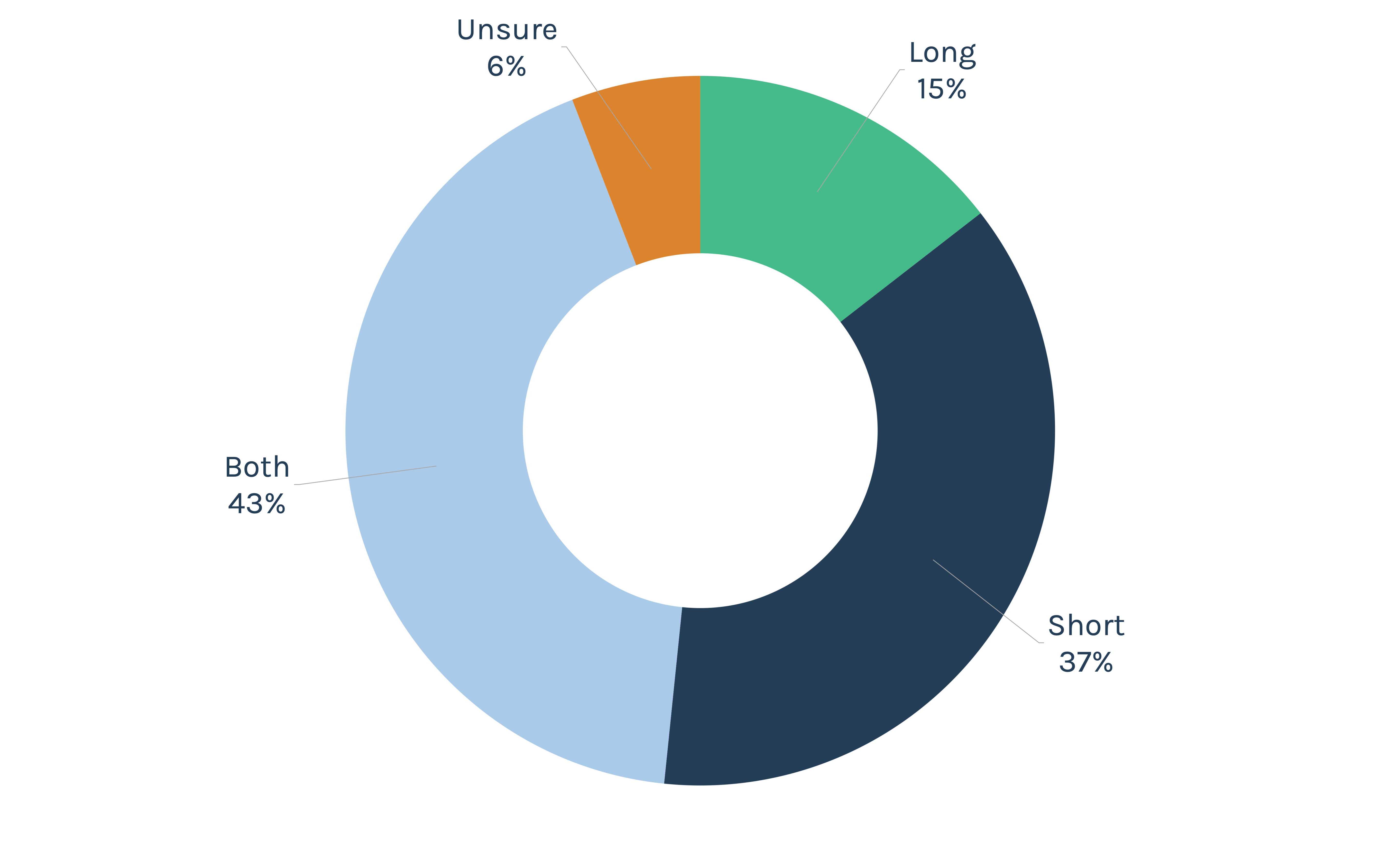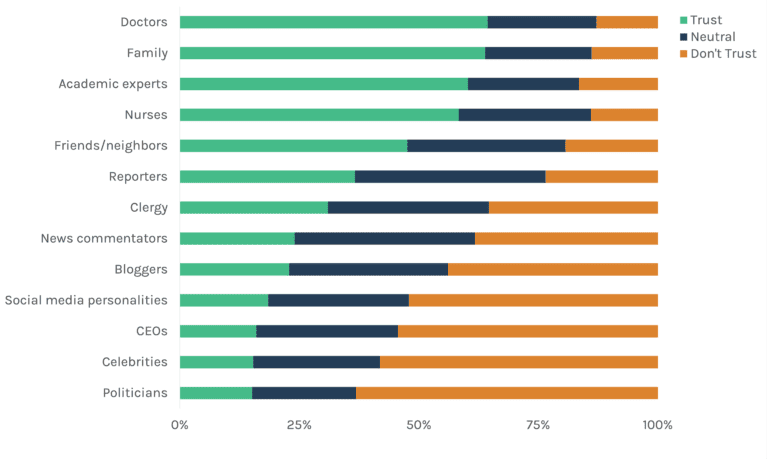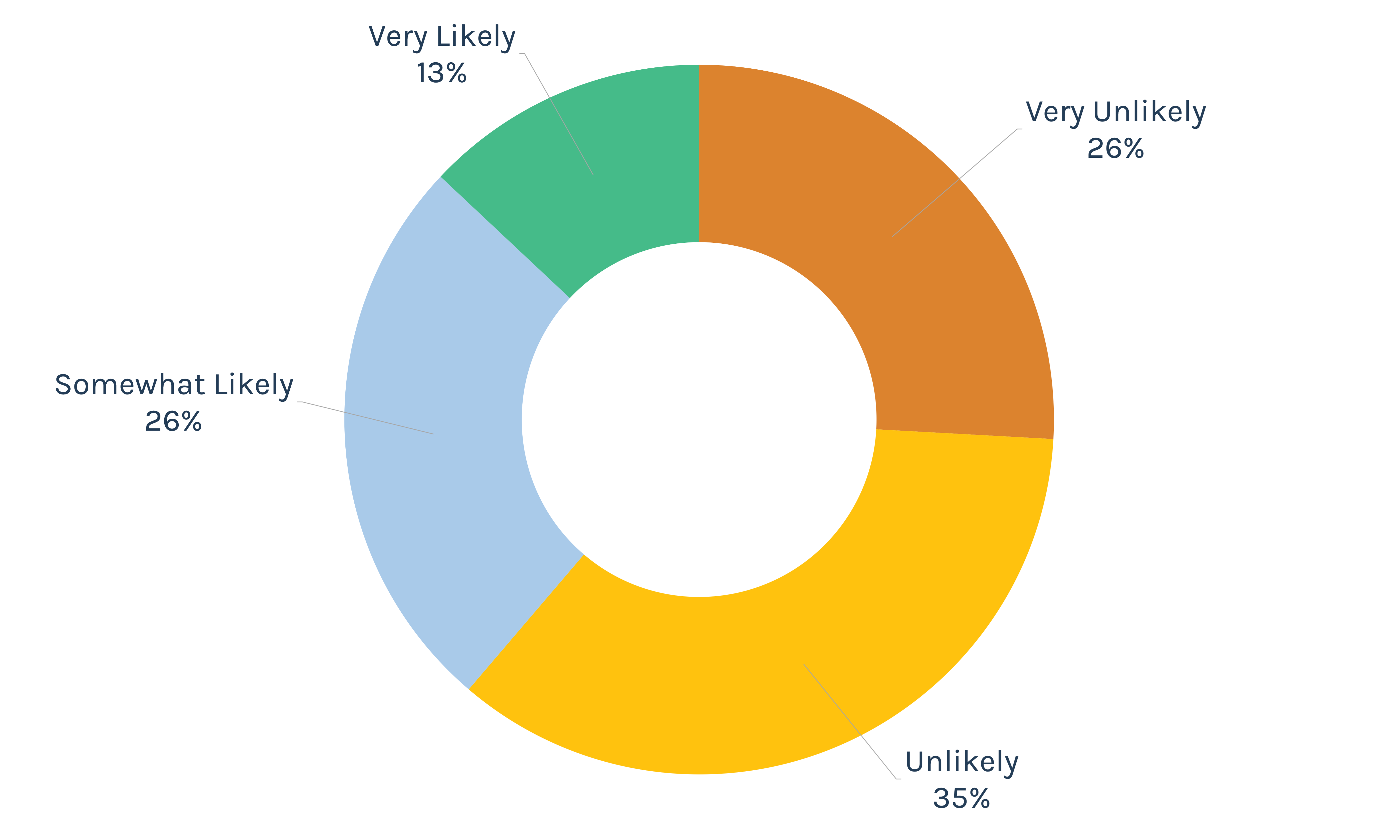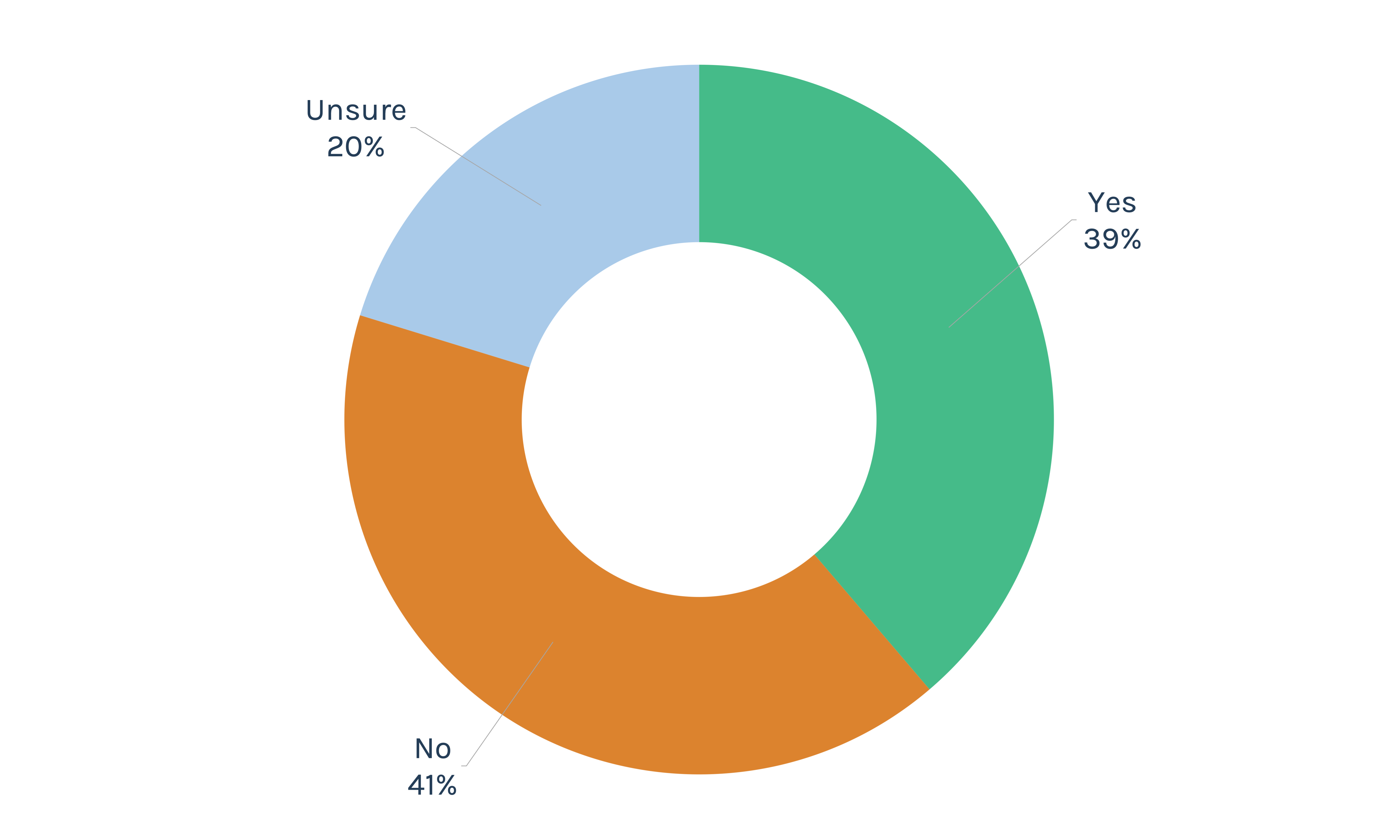Let’s make this multiple choice. Pick one or more to describe takeaways associated with current communications trends.
A. People have the attention span of a goldfish.
B. Local news is dead.
C. People aren’t willing to consider opposing viewpoints.
D. People trust family and friends.
E. People don’t trust institutions.
F. People watch, not read.
G. All of the above.
You went for G, right? Because when it comes to communications today, each of those axioms pops up with regularity. It’s impossible to catch – and hold – your audience’s attention. There’s little room for discourse. And we won’t even start on the impact of short, flashy and content-lite videos published to TikTok, Snap or YouTube.
How’s anyone supposed to cut through the noise when there’s a serious point to make and the world is distracted scrolling through memes?
We know. But first, let’s see if your choice was correct. Our proof points come from a survey Jarrard Inc. conducted in early April. Responses that follow come from 800 US adults who answered questions about how they prefer to receive information, how often and whom they trust to provide it.
Here’s what we found:
A. People have the attention span of a goldfish
58% Regularly read long-form content
Not exactly. People do prefer shorter content. But they will take the time to go deeper. More than a third of respondents said they’re more likely to read short-form content on any given day, versus just 15 percent who said long-form. But a plurality – more than four in 10 – said the average day was likely to include both. In addition, 58 percent said they read long content a few times a week or daily – the same total as short content.
On an average day, are you more likely to read long-form or short-form content?

B. Local news is dead
Wrong. It’s not. Well over half of survey respondents selected local TV as a source of news, and more than a quarter picked it as their top choice.
Where do you go for your news? (Pick all that apply)
What is your top choice for getting news?
Though perhaps surprising, these findings are consistent with other studies over the past few years. A rapid decline in local TV viewership was arrested and somewhat reversed during the stay-at-home days of the pandemic.

C. People trust family and friends
This checks out. Especially the family part. Throughout human history, people have made their way into tribes and are skeptical of outsiders. It’s evolutionary hardwiring in place to boost safety and overall success. Ergo, it makes sense that when asked about who they trust, family tops the list in a statistical dead heat with doctors. An important note here about that trust in doctors: If you’ve been following our surveys for a while, you know that we consistently highlight physicians and nurses as trusted voices on healthcare issues. This survey – related to but distinct from that series – asked a more general question about whether people trust information in general from different sources, not just healthcare information. That doctors remain at the top of the list shows the depth of that inherent trust, even beyond their professional expertise.
The slightly wider circle of friends and neighbors is far less trusted, yet still sits at almost 50 percent. People want social proof and trust loved ones – even above information they find when looking for insight on a topic.
Importantly, though, expertise is still highly valued, with academic experts and nurses rounding out the list of most-trusted individuals. Family matters, but so does deep professional training. CEOs, brace yourselves. You barely avoid the bottom spot, perennially occupied by politicians.
C. People trust family and friends
This checks out. Especially the family part. Throughout human history, people have made their way into tribes and are skeptical of outsiders. It’s evolutionary hardwiring in place to boost safety and overall success. Ergo, it makes sense that when asked about who they trust, family tops the list in a statistical dead heat with doctors. An important note here about that trust in doctors: If you’ve been following our surveys for a while, you know that we consistently highlight physicians and nurses as trusted voices on healthcare issues. This survey – related to but distinct from that series – asked a more general question about whether people trust information in general from different sources, not just healthcare information. That doctors remain at the top of the list shows the depth of that inherent trust, even beyond their professional expertise.
The slightly wider circle of friends and neighbors is far less trusted, yet still sits at almost 50 percent. People want social proof and trust loved ones – even above information they find when looking for insight on a topic.
Importantly, though, expertise is still highly valued, with academic experts and nurses rounding out the list of most-trusted individuals. Family matters, but so does deep professional training. CEOs, brace yourselves. You barely avoid the bottom spot, perennially occupied by politicians.
How much do you trust information from each of the following sources?
(Scale of 1-5: 1 = Do not trust, 3 = Neutral, 4-5 = Do trust)

In general, how much do you trust information from…
(Scale of 1-10: 1-3 = Very little, 4-5 = A little, 6-7 = Somewhat, 8-10 = A great deal)
D. People aren’t willing to consider opposing viewpoints
How likely are you to change your opinion based on a statement by/discussion with someone with an opposing viewpoint?

In the past year, have you changed your opinion based on a statement by/discussion with someone with an opposing viewpoint?

This was quite the surprise. In this time of bumper stickers, polarization and tribalism, it seems counter to the conventional wisdom that people might be willing to consider ideas they don’t already agree with. Yet, almost four in 10 respondents say they had in the past year changed their opinion based on ideas from someone with an opposing viewpoint. And another 40 percent says they just might.
Of course, this is all self-reported and might reflect the respondents’ desire to be perceived as open-minded than actual open-mindedness in practice. Even so, this is cause for optimism. Because, at minimum, there’s a segment of the population that wants to be thought of as open-minded.
E. People don’t trust institutions
True. If family and doctors are highly trusted, CEOs are, well, not. Though not asked in the survey, it’s not a big leap to see how the idea of a “CEO” here could be interpreted as either the individual – the head of a corporation – or as a proxy for the corporation itself. The dark suit, if you will. This is a warning for any institution and leader. People are relational, looking for information and reassurance from other individuals while holding a notable skepticism of organizations.
F. People watch, not read
Video is king. If you’re in marketing and communications, you’re keenly aware that short, visually engaging content is the way to consumers’ hearts. Our survey reinforced this position. Almost half of people expressed a preference for video – 18 points above written text and 3.5-times more than audio. This doesn’t mean that other media are dead. Just that visual content must be a core component of any communications strategy.
Which format do you prefer for receiving/consuming news and information?
Advice
Those are the findings. Now, what does it all mean for healthcare communications?
From our survey, one core message supersedes all others:
There’s a tendency to measure success by activity, not influence. Yet the real movement may be hidden.
It’s away from measurable campaigns like social media and billboards. And it’s found in the conversations between doctors and patients, family and friends. The ROI of relationships and interpersonal trust is unquantifiable but invaluable.
For marketing and communications advisors, this is straight talk that bears repeating: Our activity is not “it.” The hard work is in earning the conversations that take place around the dinner table.
There’s hardcore – though perhaps not entirely quantifiable – benefit to “Dinner Table ROI.” The local and personal nature of communications, trust and healthcare – along with the high trust doctors and nurses continue to enjoy – means that healthcare brands may very well be sturdier than the hot-take Twitterati say they are. The experience a strong brand provides is far more enduring than a Twitter storm. If you’ve built a strong reputation, then when the hot takes come in, those dinner conversations will include a heavy dose of people telling their loved ones, “That wasn’t my experience,” or, “I’d still go see Dr. Smith.”
We’ve written before that providers should not passively rely on an historic positive reputation. Or on the personal trust between doctor and patient. Foundational as those things may be, they’re not inviolable. Patients can choose to follow a physician rather than a hospital. And the low trust in institutions means that no corporate reputation is safe, especially in a time when hospitals are under significant fire. We stand by that advice and suggest that the strength healthcare organizations maintain is a starting point to build from, not a resting place.
How to build? Forget the Three Rs. Your answer lies in Six Ts.
Time
The first step to moving someone to action isn’t giving them new information. It’s overcoming resistance to receiving new information. “It’s a long journey to persuade people even to receive the information, much less change their mind based on it,” said Teresa Hicks, associate vice president in Jarrard Inc.’s National and Academic Health Systems Practice.
So focus internally first to make the most of that time, says Abby McNeil, vice president in the National and Academic Health Systems Practice. While there’s a lot of value to be had in media relationships (see sidebar) healthcare communications leaders need to focus initially on physicians, employees, partners, and other internal stakeholders. “Because we trust people we know most, their experience, along with the patient/consumer experience, is what moves the needle fastest with brands either in a positive or negative way.”
Trust
There’s good and bad in the trust numbers from our survey. On one hand, it’s easier to receive information from a cherished sister or brother instead of reading a stack of articles for yourself. “There’s an element of comfort that comes from that relationship,” Hicks noted. Yet depending on the information shared between sisters, that could be a good thing – “Go get your COVID-19 vaccine!” – or a bad thing – “the COVID-19 vaccine contains tracking devices!”
Kim Fox, partner and Regional Practice lead at Jarrard Inc., added, “The dinner table is a safe place. You can explore your perspective and feelings there. You can openly be your true self, whereas you often can’t in other settings.”
For healthcare organizations, the charge then is:
And what of spokespeople? Well, your physicians, nurses and academic experts remain high on the trust list. CEOs? Not so much. We think that in many cases, the word “CEO” could easily be viewed by many as a proxy for “corporation.” When faced with a critical message – or even just day-to-day communications – provider organizations must be careful to use the person who is best suited to deliver it, even if that person may not be the most prominent. We typically see this in advertising: It’s white coats in hospital TV ads, not suits.
Of course, there’s also a big difference between “CEOs” in general and Jane Doe, CEO of Anytown Medical Center. So, there’s certainly an opportunity for any leader to be a trusted voice. That trust must be cultivated, which McNeil references in media training sessions. “I tell leaders they have to make deposits in the community trust bank daily, because at some point there will be an issue or a crisis, and they’ll have to make a withdrawal,” she said. “Those deposits happen at every single touchpoint with the brand.”
Last note here: Fox pointed out another subtle but important distinction in the trust numbers. “People don’t trust celebrities. Providers should be careful about if and when they use celebrities as spokespeople.” she said. “They’re known, but not trusted.”
Why Are Doctors So Highly Trusted?
We noted above that doctors aren’t just trusted on health information, they’re trusted even when the question is about information writ large. Why? Fox had an idea. Perhaps it’s because of their unique position as recipients of our secrets. “We may trust doctors because they hear things that we won’t say even to our families,” Fox suggested. While the dinner table is, in Fox’s terminology, a safe space, the doctors’ office is reserved for discussing a subset of deeply personal concerns. Arguably, clergy have historically held this position, yet they fell in the middle of the trust list in our survey (fallout from the decline of organized religion, perhaps). Could it be that the knowledge that our medical caregivers know things about us no one else does lead to trust, or even force it? Or is the trust necessary up front for us to feel comfortable being open with our physician? It’s an intriguing chicken and egg question we don’t have an answer to but will be pondering.
Translation
Almost everything we know has been interpreted for us by someone who understands it better than we do.
Sounds scary, but is it? Not really. We need experts to discover and then translate since no one knows everything. Society needs specialists to develop ideas and make discoveries, but then it also needs a series of people to translate that information into something we all can use. And at the end of that chain must be a trusted, one-on-one interaction.
That’s why hearing from a family member is far more palatable than digging through mountains of primary literature.
So too with health information. Healthcare providers need to remember that the process of translation is good and necessary. Done correctly, the process makes the complex and unintelligible something that can be processed by, well, anyone who isn’t the expert. This means investing in people and processes that can review critical messages and adapt them as needed. It’s taking an active approach – not just asking a charismatic physician to go out and extoll the virtues of vaccines or colonoscopies. It’s building a pipeline to finesse information into a format and level that is exactly what the audience needs. Playing a huge role in this is your marketing and communications team who should both identify the core message, shape and review it for accessibility and then develop final products that engage the end user.
Training
Smart healthcare providers invest in training trusted voices to communicate effectively.
“We can work to make the people who can translate trusted,” said Hicks. “But… that’s a lot harder than finding someone who’s already trusted and giving them the skills they need to translate.” That doesn’t mean sending community leaders to a crash course in immunology and vaccine development, but it does mean sitting down with them and the specialists – those in the first and second layers of translation, if you will – to walk through the information, its impact and how people should respond.
You’re familiar with examples of health systems working with clergy to promote the COVID-19 vaccine. Another example could be a local facility engaging with EMS directors across a community to explain how and why consolidation of emergency services will work – and why it makes sense for the community.
“Whatever the topic is, finding the people who already have earned the trust of their community and investing in convincing those people to share the information is the way to go,” Hicks said. “Because this survey shows that people trust relationships more than they trust data.”
Tactics
Whatever the message and whomever the messenger is, how should it be delivered? Here’s where that preference for short form and video comes in to play. The data is clear and is largely consistent with marketing and communications best practices, so we won’t dwell on this tactic for long.
Still, it’s worth noting that the results reinforce the value of brief videos, delivered on a regular basis. People are looking at short-form news a few times a week. They strongly prefer video over audio and text. Therefore, they’re primed for that style of communication when it comes time to look at health information.
But remember that, despite the preference for short-form content, there’s a place for long-form. Those quick hit pieces can be backed up by deeper materials for those who want more. Fox noted that there is always a need for multiple channels. The survey, she said, reminds us that “People will still read a good story. Not everything has to be three paragraphs long. There’s a market there for deep content, as long as it’s well-written, well-researched and thoughtful.”
Touchpoints
By that, we mean experience. Consider the “body language” of an organization and the experience it offers. “Perception comes down to experience,” McNeil said.
The right words at the right time are important but not remotely sufficient. More significant is creating a good experience at every stage of the patient and employee journey through the organization. She referred to the survey data as “a callback to how we show up with patients and consumers, with employees and physicians, every single time.”
Remember that a sizeable portion of the population either is open-minded or wants to be perceived as open-minded. Remember, almost 40 percent of survey respondents said they had changed their opinion in the past year based on an opposing viewpoint. Both demonstrate sensitivity to social norms.
Therefore, those leading communications for provider organizations should be encouraged to keep up with efforts to persuade – whether the issue is public health measures or service line changes.
The key is to build those messages into bite-sized, emotionally compelling nuggets that can be easily delivered through personal relationships far away from the PSAs and media campaigns. Then, as the door is cracked wider, have ready more in-depth information that will build momentum towards the end goal rather than put people into vapor lock through confusion, defensiveness and decision paralysis.
Remember: Every opportunity to back the story up by a personal, positive and comfortable experience serves as a deposit in the bank.
“No presentation with vast amounts of data will be palatable enough to make someone change their mind,” said Hicks. “It has to be the relationship that does that.”
Closing Thoughts
Where’s Local Media In All This?
A key finding of our survey was that local news is not dead. What should healthcare providers do with that? Our Jarrard Inc. team has some thoughts on the state of the media:
- Generalist Reporters. There’s a wide variation in local TV reporting. Many reporters are doing their best on limited budgets and lack of resources needed to specialize in healthcare, business, etc. As you work to form meaningful, educating relationships with the editorial staff or news director, work hard to translate and put the news into context for them.”
- Relationship Building. Like anything, building that relationship takes time. Meet with the reporter or news director to talk through key issues and serve in that translator role. Ongoing, long-form conversations build a personal relationship and give the reporter a vested interest. Make them feel a partner in serving the community. Professional responsibility means journalists will want to know that they’ve done their homework, looked at both sides and appropriately simplified complex information so it’s available to the public. You can be an asset in this process.
- Beware the Dark Side. We’re talking about the push for ratings, sensationalization. Provider organizations interacting with TV reporters need to be aware of details like sweeps week, the four times each year when ratings are calculated. Though it’s not necessarily a negative, Muck Rack’s 2022 State of Journalism survey found that reporters say having a subject connected to a trending story was the best way to make a story shareable. Similarly, local reporters are often working to move up to a bigger market. Most are doing that by doing great work and telling important stories well. But there are, as with anything, exceptions to that generalization. Ratings will be in the back of the reporter’s mind. Layer on top of that the need to tell stories in 30-90 seconds and there’s a risk of sensationalizing.
Want more specifics on how reporters want to be pitched? Here are a few very tactical stats from the Muck Rack State of Journalism report:
4 Average number of beats each journalist covers
84 % Journalists who consider academic experts credible sources
66% Journalists who consider CEOs credible sources
Questions about how to communicate more effectively with the audiences that matter? We can help.
Subscribe to Jarrard Insights & News
"*" indicates required fields




